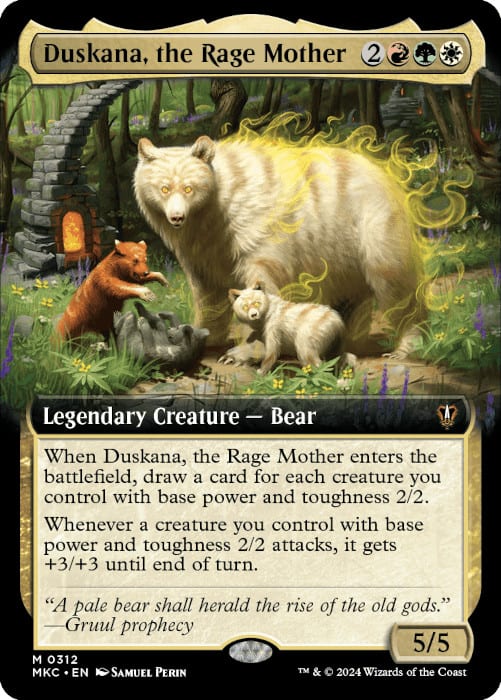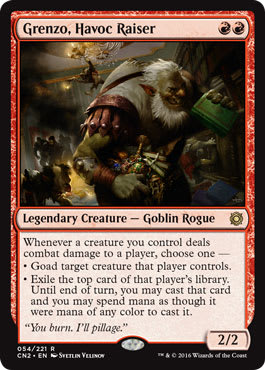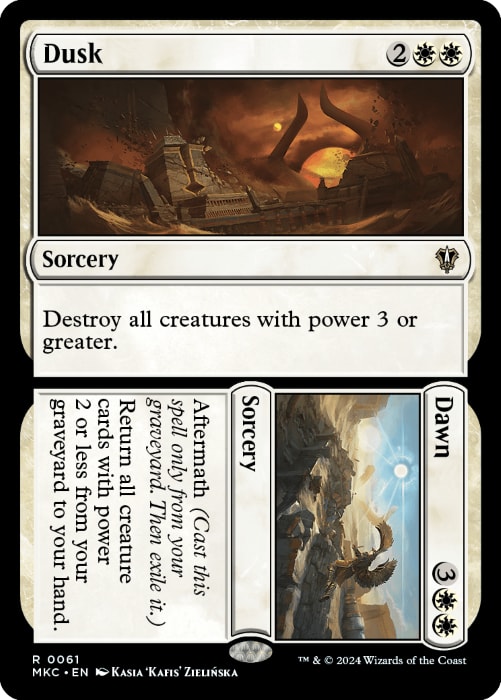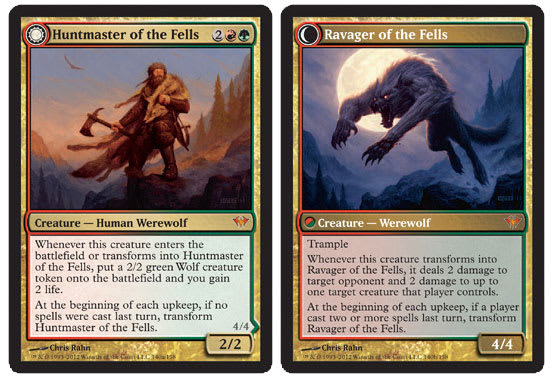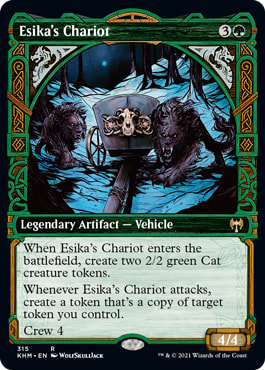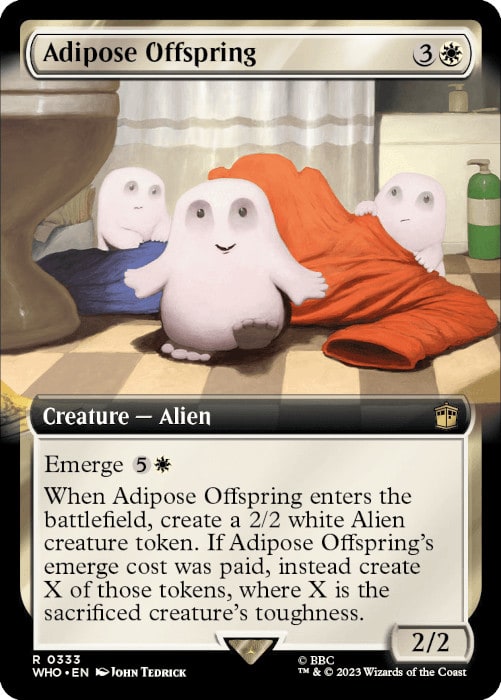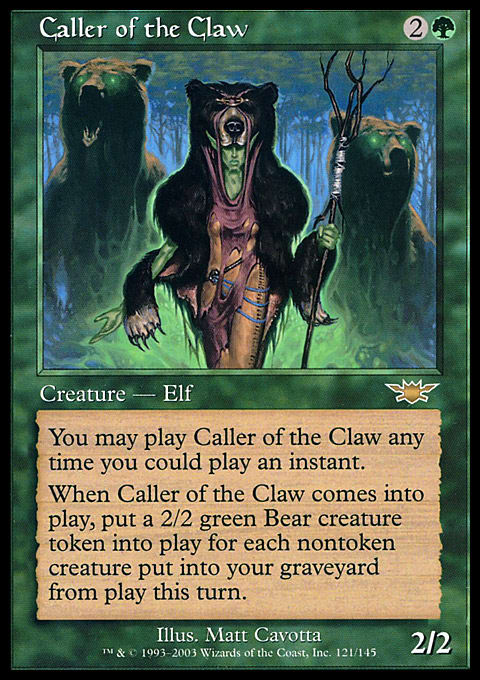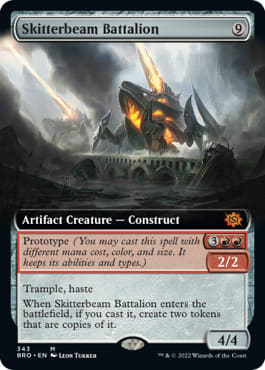One of my favorite pieces of Magic terminology is the word "bear." Originating with the card Grizzly Bears, a bear is a creature with a 2/2 statline, preferably (but not necessarily) with a mana cost of two. Bears may or may not have abilities, but they'll function reasonably well as early game creatures either way. While they may be easy to confuse with one another, bears are distinct from the creature type bear. Alpine Grizzly is a bear that's not a bear, while Pygmy Hippo is a bear that's not a bear. I hope you're not too confused, because Duskana, the Rage Mother is a bear that's not a bear that cares about bears that may or may not be bears.
Let's take this from the top. Duskana, the Rage Mother is a five-mana 5/5 in Naya (![]()
![]()
![]() ) colors with the creature type bear. When she enters the battlefield, you draw a card for each creature you control with base power and toughness 2/2. Base power and toughness are the numbers printed on each card, and can only be changed by effects that specifically set those base stats to something else. Because base stats are unaffected by most external buffs, your creatures can have as many +1/+1 counters or swords as you like without Duskana's strength being affected. This ability can provide an impressive amount of card draw, but it's especially impressive when you take it into account alongside her hefty size and second triggered ability. Whenever a base 2/2 creature you control attacks, Duskana will give it +3/+3 until end of turn, buffing it to match her 5/5 statline. I cannot overemphasize how impactful this is. With this buff alone, an unblocked creature will go from dealing a twentieth of an opponent's starting life to an eighth of it. That's big.
) colors with the creature type bear. When she enters the battlefield, you draw a card for each creature you control with base power and toughness 2/2. Base power and toughness are the numbers printed on each card, and can only be changed by effects that specifically set those base stats to something else. Because base stats are unaffected by most external buffs, your creatures can have as many +1/+1 counters or swords as you like without Duskana's strength being affected. This ability can provide an impressive amount of card draw, but it's especially impressive when you take it into account alongside her hefty size and second triggered ability. Whenever a base 2/2 creature you control attacks, Duskana will give it +3/+3 until end of turn, buffing it to match her 5/5 statline. I cannot overemphasize how impactful this is. With this buff alone, an unblocked creature will go from dealing a twentieth of an opponent's starting life to an eighth of it. That's big.
As a Commander, Duskana lends herself well to a relatively aggressive strategy. You spend your first few turns ramping and playing 2/2 creatures, until you reach the point where you can play Duskana. When she enters the battlefield, she'll help refuel your hand with her card draw, and can simultaneously make your board of tokens and utility creatures significantly more threatening. There are a multitude of powerful bears with useful abilities, many of which are worth playing on their own. Duskana rewards you for using these often underlooked creatures, and does a great deal to help them shine.
Bear is Bear
We'll want to start the game with ramp and utility creatures, so we'll begin with some of those. So, I don't have to repeat it twenty times, assume every creature I go over is a 2/2 unless mentioned otherwise.
I consider Black Market Tycoon one of the most overlooked mana producers in the format. A two-mana creature, this cat rogue can be tapped to create a treasure token. However, at the beginning of your upkeep, they'll deal 2 damage to you for each treasure you control. So long as you aren't planning to hoard treasures, this is a fairly manageable drawback. The ability to store mana for later turns is quite powerful, and gives Black Market Tycoon a significant edge over a typical mana dork. Requiring two colors of mana to cast can make it more difficult to reliably play on curve, which can be problematic for a ramp card, but this card has numerous unique strengths to compensate for that.
Another underrated Gruul (![]()
![]() ) ramp creature, Atalan Jackal is unbelievably stacked. For three mana, you get a creature with trample, haste, and a combat damage trigger. When it deals combat damage to a player, you can search your library for a basic land, and put it into play tapped. In the early game, where at least one player is likely to be incapable of blocking it, this card can quickly send you rocketing ahead of your opponents in mana. Later on, a 2/2 with minimal evasion will likely struggle to connect with an opponent's face, but that's where Duskana comes in. A 5/5 with trample is significantly harder to block than a 2/2 with trample, allowing Atalan Jackal to remain relevant into the mid to late game.
) ramp creature, Atalan Jackal is unbelievably stacked. For three mana, you get a creature with trample, haste, and a combat damage trigger. When it deals combat damage to a player, you can search your library for a basic land, and put it into play tapped. In the early game, where at least one player is likely to be incapable of blocking it, this card can quickly send you rocketing ahead of your opponents in mana. Later on, a 2/2 with minimal evasion will likely struggle to connect with an opponent's face, but that's where Duskana comes in. A 5/5 with trample is significantly harder to block than a 2/2 with trample, allowing Atalan Jackal to remain relevant into the mid to late game.
A relatively recent staple, Archivist of Oghma is one of the format's best sources of White card draw. A 2-drop creature with flash, he'll gain you one life and draw you a card whenever an opponent searches their library. The power of this ability will depend heavily on your playgroup. If your opponents are playing a lot of tutors, ramp, and fetchlands, Archivist of Oghma can be comparable in power to a card like Esper Sentinel, potentially surpassing it in certain situations. Conversely, if your opponents play few of those effects, it can be more comparable to Ashcoat Bear, which isn't a terrible thing. While the most obvious way to use Archivist of Oghma's flash is to play him in response to a spell or ability that searches an opponent's library, an instant speed blocker can turn the tide of a combat step, no matter its size. A 2/2 can still be thrown in front of a deadly threat, or it can kill an attacker with a double block.
Deep Gnome Terramancer shares several similarities with Archivist of Oghma. Both are two mana 2/2 creatures with flash and a triggered ability. Instead of giving you cards when opponents search their libraries, Deep Gnome Terramancer helps you keep up with them in mana. When an opponent's land enters the battlefield without being played, you can search your library for a plains and put it into play tapped. This effect is a bit more narrow than Archivist's ability, but is no less powerful. Against most Green decks, or any decks that play fetchlands, this creature is extremely efficient, and decently likely to trigger at least a few times over the course of most games. Even when this card is at its weakest, however, it's still a bear with flash, which is far from the worst thing a creature can be.
A powerful Red legendary creature from Conspiracy: Take the Crown, Grenzo, Havoc Raiser is a phenomenal engine for aggressive decks. A classic two-mana 2/2 (nonliteral) bear, Grenzo has an ability that triggers whenever a creature you control deals combat damage to an opponent. When that happens, you can choose between two effects, either goading a creature that player controls or exiling the top card of their library. When you exile a card this way, you can cast it that turn using mana of any color. Goad is extremely versatile, allowing you to keep dangerous creatures out of your hair, ensure an opponent can't leave up blockers, or force a utility creature into combat where it can be blocked and killed. If an opponent doesn't have good targets to goad, however, you can instead use Grenzo as a card advantage engine. Casting things from your opponent's deck usually won't be as good as playing things from your own, but it's still far better than running out of gas entirely.
Delney, Streetwise Lookout is an incredibly powerful creature, more than justifying their $20 price tag. For three mana, they're a 2/2 with two abilities that affect your creatures with two or less power. The first prevents them from being blocked by creatures with three or more power. A decent evasion effect, but not particularly useful for us, as Duskana will buff your attacking creatures out of Delney's range. Their second ability is more relevant, copying the triggered abilities of the aforementioned creatures. This ability makes Delney most comparable to Roaming Throne, which has rapidly proven itself a Commander staple (as well as a card I can't seem to stop mentioning in my columns). Delney is capable of doubling any triggered ability from most of the non-commander creatures in this deck. The majority of those creatures have a triggered ability of some sort, and with the notable exception of Black Market Tycoon, every single one is positive.
Another classic bear, or Ours Classique, if you will, Charming Prince is a simple rare from Wilds of Eldraine. When he enters the battlefield, you can choose between one of three effects. You can either scry 2, gain 3 life, or exile another creature you own until the next end step. In this deck, I struggle to imagine a scenario where you choose the life gain, but the scry does have a meaningful niche. If you play out Charming Prince in the early game, scrying will usually be your best option, allowing you to help smooth out your draws while playing a 2/2 for later. That third effect is Charming Prince's bread and butter. Duskana's ETB trigger is the way we intend to stay in the game later on, and the ability to reuse it while also playing a 2/2 for two is just too good to pass up.
Hailing from Amonkhet, aftermath is a bit of an odd ability. While the way the cards with the ability are formatted is quite unorthodox, it's not as intimidating as it might seem, functioning like a combination of flashback and a split card. You can cast the first part of the card from your hand, while you can only cast the second part from your graveyard. With that settled, the actual card I'm bringing up is Dusk // Dawn (read as "Dusk to Dawn"). Dusk is simple, a four-mana sorcery that destroys all creatures with power three or greater. Ironically, Dusk will kill Duskana, but it will miss the vast majority of our other creatures. While it's an acceptable board wipe, four mana is higher than what you'd prefer to pay for this effect on its own. Thankfully, however, it's not just a board wipe. After you play Dusk, you'll have the opportunity to cast Dawn from your graveyard. For five mana, Dawn will return each creature with power two or less from your graveyard to your hand, allowing you to refuel later into the game.
Six-mana planeswalkers are often rather polarizing. Investing that much into a card as vulnerable as a planeswalker can leave you in a precarious position if you fail to protect them, so to compensate for this, the card needs to do a lot to justify their price. The Eternal Wanderer does exactly that, at least in this deck. Starting with five loyalty and a passive preventing multiple creatures from attacking her at once, she's remarkably hardy for a planeswalker. Her +1 ability exiles an artifact or creature until its owner's next end step, which can either flicker Duskana or take a threat out of the picture for a turn. For 0 loyalty, The Eternal Wanderer's second ability creates a 2/2 samurai token with double strike, which can quickly produce an overwhelming board state. With a Duskana buff, a single unblocked samurai takes off a quarter of an opponent's starting life total, and that samurai is nearly impossible to block profitably. While a 1/1 can easily chump block this threat, you can prioritize attacking the opponents with the fewest disposable creatures, forcing them to choose between sacrificing their board presence or tanking that damage. Finally, this planeswalker's -4 ability will force each player to sacrifice all but one of their creatures, clearing out the board while leaving The Eternal Wanderer at one loyalty, ready to pump out tokens if she isn't dealt with.
Too Many Tokens
Flooding the board with creature tokens will be a key part of our strategy, because it's the part that allows us to actually end the game. Beating our opponents to death with an army of 5/5 2/2s might not be a sophisticated strategy, but it's the one Duskana best facilitates.
Spawnwrithe is a card that I've been fond of for nearly as long as I've played Magic, but I've long struggled to find a good home for it. This deeply unsettling elemental is a three-mana 2/2 with trample which creates a token copy of itself whenever it deals combat damage to a player. Unfortunately, this card is just too slow and fragile for most decks. Thankfully, Duskana provides the perfect place for this card to shine. If we play Spawnwrithe on turn three, we can attack an open player on turn four, and begin turn five with a pair of Spawnwrithes. In this situation, we have multiple lines of play. If an opponent is still unable to block your 2/2s with trample, you can attack to create two more tokens, and then play Duskana to draw four cards off of this creature alone. Alternatively, a more aggressive line would see you play Duskana before combat. You'll miss out on two cards, but instead of hitting someone for four, you can hit them with a pair of 5/5 tramplers, which most opponents will struggle to profitably block this early in the game.
A widely beloved card I haven't had much chance to use in the past, Huntmaster of the Fells does a little bit of everything. For 4 mana, this 2/2 werewolf provides you with lifegain and a 2/2 wolf token when he enters the battlefield. Already a good start, but that's not all. When no spells are cast during a turn, he'll transform into Ravager of the Fells the next upkeep, becoming a 4/4 with trample, dealing 2 damage to a player or planeswalker, as well as another 2 damage to a creature the targeted player (or the planeswalker's controller) controls. Then, if two or more spells are cast in a turn, Huntmaster will return, giving you more life and another wolf. Even though we don't have an enormous amount of control over when Huntmaster transforms, he's still likely to flip a few times over the course of a game, and as he does, he can generate staggering amounts of value.
Esika's Chariot is one of the strongest vehicle cards that's seen print, because it's one of the few that can be entirely self-sufficient. Because vehicles can only become creatures if you have other creatures to crew them, their performance is inherently dependent upon other cards. On a totally empty board, most vehicles are dead draws. Esika's Chariot subverts this norm by creating a pair of 2/2 cat tokens when it enters the battlefield, providing enough power to crew it immediately. When crewed, Esika's Chariot becomes a 4/4 creature, and you create a copy of a token you control when it attacks. With Duskana out, your cat tokens might be better utilized attacking, but Duskana herself provides a convenient answer for that. If she's pulling the Chariot, she can contribute to combat while staying out of harm's way, and help create more tokens in the process.
While I know very little about Doctor Who, I'm more than familiar with Magic, and Adipose Offspring is an excellent Magic card for this deck. This four mana alien is a 2/2, and creates a token with the same statline when it enters the battlefield. That's already pretty decent for us, but it isn't the end of the story. Adipose Offspring can also be cast for its emerge cost of six mana, sacrificing a creature and reducing that cost by its mana value. When you cast this creature for its emerge cost and it enters the battlefield, it creates a 2/2 alien token for each point of toughness the sacrificed creature had, instead of just one. While most of our creatures are quite small, we can play Adipose Offspring on our second main phase, and sacrifice a creature that attacked and received Duskana's +3/+3 buff. In that case, you'll sacrifice one 2/2 for six 2/2s, each of which will be attacking as 5/5s.
So, let's say you have a big pile of bears, but then something happens to them. Someone casts a Blasphemous Act, or a Wrath of God. Now what do you do? The answer is simple. You play Caller of the Claw. On top of putting in work as a three-mana 2/2 with flash, a mechanic I've already sung the praises of, when this creature enters the battlefield, it creates a 2/2 bear token for each of your nontoken creatures that died this turn. This effect works as an excellent way to rebuild your army after a board wipe, but that isn't the only way it can be used. Even a single 2/2 can make an impact in this deck, and a pair of them for only three mana at instant speed is perfectly playable. Caller of the Claw can remain valuable when one of your creatures eats a removal spell or has to be thrown in front of a big threat.
There are few things in the Commander format more frowned upon than mass land destruction. Lands are important, and nothing makes it harder to play Magic than not having enough of them. Cards like Sylvan Awakening can be intimidating to more risk averse players for this very reason, as they leave your lands vulnerable to board wipes, but they can more than pull their weight if given the opportunity. Sylvan Awakening is a three-mana sorcery that turns your lands into 2/2 creatures with reach, haste, and indestructible until your next turn. While indestructible helps mitigate the risks this card requires you to take, there are a number of board wipes still liable to blow you out, like Toxic Deluge or Black Sun's Zenith. There's nothing that feels worse than being hoisted by your own petard. That risk doesn't come without reward, though. For only three mana, Sylvan Awakening can provide a sizable number of temporary creatures. Those creatures can attack as 5/5s with Duskana, but you can also leave them back as indestructible blockers. Attacking will represent a substantial mana investment, as your lands won't have vigilance, but losing out on 1 mana to swing with a 5/5 is a price I'm more than willing to pay.
While Skitterbeam Battalion is technically a nine-mana 4/4, we will literally never play it as one. For only five mana, we can cast it for its prototype cost in exchange for halving its statline. This artifact creature also has trample and haste, and when it enters the battlefield, it creates two token copies of itself if it was cast. With Duskana, the prototype mechanic's base stat reduction can become an upside, totally flipping the script on this card's performance. By paying the reduced cost, we actually make Skitterbeam Battalion stronger. For only five mana, we can attack with 15/15 of stats, with trample and haste. That's pretty impressive. It'd be a shame if another card completely blew it out of the water right away, but that won't happen, right? Wizards of the Coast would never print a preposterously overtuned card in one of their Universes Beyond Commander sets.
Oh.
All jokes aside, I do not understand why Forth Eorlingas! is the way that it is. For a Red, a White, and a payment of X, you create X 2/2 Human Knight tokens with trample and haste. That's already pretty impressive. You could remove one of those keywords and the entire second half of this card's text, and it'd still be reasonably playable. Why does it also make you the Monarch when you deal combat damage to an opponent? If any of your creatures make it through against anyone, this spell cantrips. If you can protect or maintain your claim to the throne, it can even give you card advantage, on top of everything else. This card is absurdly broken, costs twenty dollars, and its name contains an exclamation point for some reason, which makes it look really weird when you write about it.
The Deck
This deck turned out a lot stronger than I anticipated. Sophisticated or not, beating our opponents to death with cheap creatures is an undeniably effective strategy. Unfortunately, this list isn't without its weakness. We're very heavily reliant on Duskana. If we fail to resolve her or aren't able to recast her when she's removed, our gameplan can find itself dead in the water. Without the card draw and stopping power our commander provides, our deck will often struggle to do much. This can be especially problematic when you consider that our gameplan is fairly aggressive and commits heavily to the board. When other players consider us a threat, they're significantly more likely to target us with their removal, and it's difficult to do something more overtly threatening than drawing a bunch of cards and attacking for 20 on turn five.
Duskana, the Rage Mother | Commander | Lilian Johnson
- Commander (1)
- 1 Duskana, the Rage Mother
- Planeswalkers (2)
- 1 The Eternal Wanderer
- 1 The Wandering Emperor
- Creatures (34)
- 1 Adipose Offspring
- 1 Archivist of Oghma
- 1 Atalan Jackal
- 1 Beast Whisperer
- 1 Black Market Tycoon
- 1 Bounty Agent
- 1 Bramble Familiar
- 1 Bronze Walrus
- 1 Caller of the Claw
- 1 Captain Lannery Storm
- 1 Charming Prince
- 1 Deep Gnome Terramancer
- 1 Delney, Streetwise Lookout
- 1 Duskwatch Recruiter
- 1 Goblin Anarchomancer
- 1 Grand Abolisher
- 1 Grenzo, Havoc Raiser
- 1 Guardian Augmenter
- 1 Huntmaster of the Fells
- 1 Knight of the White Orchid
- 1 Kutzil, Malamet Exemplar
- 1 Llanowar Visionary
- 1 Manglehorn
- 1 Mentor of the Meek
- 1 Palace Jailer
- 1 Qasali Pridemage
- 1 Radha, Heir to Keld
- 1 Rishkar, Peema Renegade
- 1 Scavenging Ooze
- 1 Skarrg Guildmage
- 1 Skitterbeam Battalion
- 1 Skyclave Apparition
- 1 Skyhunter Strike Force
- 1 Spawnwrithe
- Instants (6)
- 1 Assure // Assemble
- 1 Eerie Interlude
- 1 Ephemerate
- 1 Get Lost
- 1 Heroic Intervention
- 1 Swords to Plowshares
- Sorceries (9)
- 1 Bala Ged Recovery // Bala Ged Sanctuary
- 1 Dusk // Dawn
- 1 Farseek
- 1 Forth Eorlingas!
- 1 Nature's Lore
- 1 Release the Gremlins
- 1 Shatterskull Smashing // Shatterskull, the Hammer Pass
- 1 Sylvan Awakening
- 1 Three Visits
- Artifacts (3)
- 1 Arcane Signet
- 1 Esika's Chariot
- 1 Sol Ring
- Enchantments (7)
- 1 Assemble the Players
- 1 Fable of the Mirror-Breaker // Reflection of Kiki-Jiki
- 1 Felidar Retreat
- 1 Ranger Class
- 1 Rhythm of the Wild
- 1 Teleportation Circle
- 1 Virtue of Loyalty
- Lands (38)
- 4 Forest
- 2 Mountain
- 4 Plains
- 3 Snow-Covered Forest
- 1 Snow-Covered Mountain
- 3 Snow-Covered Plains
- 1 Battlefield Forge
- 1 Bountiful Promenade
- 1 Branch of Vitu-Ghazi
- 1 Brushland
- 1 Command Beacon
- 1 Command Tower
- 1 Demolition Field
- 1 Exotic Orchard
- 1 Field of the Dead
- 1 Jetmir's Garden
- 1 Karplusan Forest
- 1 Mutavault
- 1 Overgrown Farmland
- 1 Reliquary Tower
- 1 Rockfall Vale
- 1 Sacred Foundry
- 1 Spectator Seating
- 1 Spire Garden
- 1 Stomping Ground
- 1 Sundown Pass
- 1 Temple Garden
Final Thoughts
When I began working on this deck, I was impressed with the power and variety I saw among the 2/2 creatures and tokens on offer, and I appreciated the excuse to play so many underutilized cards. Duskana herself pulls a lot of weight, and while that does make her a single point of failure, it also allows her strengths to more clearly shine through. Her +3/+3 buff is extremely potent, and she can represent a great deal of card advantage as well, so long as your deck is built to accommodate her. I had seriously underestimated how dangerous this deck would be, as my last attempt to build something along these lines was ultimately fruitless.
Duskana wasn't my first attempt to make a deck like this. When I was a much newer player, I scraped together a bear typal deck around Ezuri, Claw of Progress. I saw that he cared about creatures with power 2 or less, and because bear typal commanders were nonexistent at the time, I got excited. I really wanted Bear Cub to be good. It wasn't. The deck as a whole was very bad. Blue wasn't a particularly useful color for a straightforward creature deck, and the cards in the deck had little to no synergy with the commander, as best exemplified by the presence of Phantasmal Bear, which would die if you tried to put +1/+1 counters on it. Not exactly my finest work. I've long since lost the decklist for this garbage fire, and even if I didn't, I'd still prefer not to embarrass myself by sharing it here.
The differences between that Ezuri deck and my Duskana list are night and day. While Ezuri was filled with mediocre vanilla creatures in a creature type with no lords, Duskana is packed with powerful utility creatures that happen to share the same statline. One turned out to be an unfocussed mess, and the other surpassed my expectations. What separates them? Nearly a decade of experience. I have no doubt that, in another decade, I'll be able to look back on this Duskana deck and pick it apart as well. Every deck you build, every game you play, there's always something you can learn to become a better player in the future. I'll see you in another week.
















